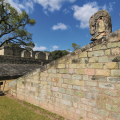PARQUE ARQUEOLÓGICO COPÁN
The discovery. One of the earliest attestations of the ruins' existence can be found in the famous letter from explorer Diego García de Palacios to King Philip II of Spain in 1576. Despite his enthusiastic description, the ruins were forgotten until 1834, when Colonel Juan Galindo led the first-ever scientific expedition there. In 1891, the Honduran government signed an agreement with Harvard University's Peabody Museum. In exchange for American support in restoring and developing the ruins, the government granted the researchers the exclusive right to import half of the objects unearthed. Thanks to this team of experts, important monuments were discovered during the excavations of 1975 and 1977, to which today's visitor owes much of the site's splendour. In 1980, the Copán ruins were declared a UNESCO World Heritage Site.
Grandeur and decadence. The golden age of Mayan civilization was between 250 and 900 A.D., a period marked by the emergence of the first royal dynasties. The king, at the head of the city, was responsible for ensuring the prosperity, security and salvation of his people. Accompanied by his closest relatives, he lived at the center of the city in temples and palaces that he had erected in his honor. At the end of some reigns, the brightly-colored stucco-covered stone constructions were buried, preserving some of Copán's beauties from destruction down the centuries.
The study of glyphs shows that the city's expansion began with the advent of a Great Lord, K'inich Yax K'uk'Mo o, in 426. His marriage to a noblewoman marked the beginning of a dynasty lasting seventeen reigns. With the reign of this king began the construction of Copán's first monuments. From the second king, son of K'inich Yax K'uk'Mo o, to the tenth king, Lune Jaguar, very little is known. The discovery of more than 4,500 buildings has enabled us to estimate that the valley's population reached 27,000 in the 8th century. Between 578 and 738, Copán enjoyed a period of demographic, political, social and artistic growth attributed to Smoking Serpent, the eleventh king (563-628), and Smoking Jaguar, the twelfth king (628-695). The latter's sixty-seven-year reign was marked by conquests and the expansion of his territory, paving the way for the advent of the man who was to make Copán the jewel of Mayan cities: Ten-Eight Rabbit (Waxaklajuun Ub'aah K'awiil). This king of extraordinary artistic affinities imposed new standards on statuary and architecture, which reached an aesthetic and technical refinement never equalled in later times. The steles A, B, C, D, F, H and 4 on the Grande Place, the Ball Court, Stele J and Temple 22 on the eastern Patio of the Acropolis are all attributable to him. Unfortunately, Eighteen Rabbit was captured by the Mayans of Quirigua and beheaded on May 3, 738. This marked the beginning of a period of political instability and economic crisis. Although Quirigua never actually conquered the city of Copán, it did take control of several agricultural lands and jade production areas that had previously belonged to Copán. It was an alliance consolidated by the marriage of the fifteenth king, Escargot Fumant, to a noblewoman from the city of Palenque, that restored Copán's prestige and stability.
The sixteenth king, Yax Pasay Chun Yooab, ascended the throne in 763, and was responsible for the construction of the famous Q altar, depicting the sixteen rulers of the Copán dynasty seated cross-legged over their names. Chance or destiny, it was with this king that we witnessed the first signs of the city's decline. Some attribute this to some mysterious event. In all likelihood, overpopulation, deforestation and agricultural overexploitation, reinforced by severe climatic variations, were the real causes of Copán's downfall. Physical archaeology studies have shown that the population suffered from various diseases and malnutrition. There was one last pretender to the throne in 822 but, as the incomplete stele L commissioned by him proves, Ukit Took' never reigned over Copán. We don't know what became of this king, but the Maya gradually abandoned the site and left the valley, drained of its natural resources.
Visit. The archaeological park is made up of the main group (Main Square, Acropolis, Cemetery) and the Sepultures site (Las Sepulturas), 3 km apart. The visit should be rounded off with a visit to the magnificent sculpture museum (at the entrance), which houses some of the original pieces that have been replaced by copies on site, as well as a majestic replica of the Rosalila temple, discovered beneath temple 16. A complete visit takes at least three hours. Visitors reach the main group by following a lovely tree-lined path past the ruins' guardians, flamboyantly coloured parrots, birds emblematic of the Mayan imagination. From the path that leads to the site, you arrive at a vast open area: the Grande Place.
A visit to the tunnels is impressive. Access is only available within the archaeological park. So it's best to make up your mind before setting out to explore the site.
Did you know? This review was written by our professional authors.
Book the Best Activities with Get Your Guide
Members' reviews on PARQUE ARQUEOLÓGICO COPÁN
The ratings and reviews below reflect the subjective opinions of members and not the opinion of The Little Witty.

nombreux temples dispersés dans la forêt
accueil des aras
Il n'y a pas énormément de monde ce qui rend la visite beaucoup plus agréable.
Plein de Ara vous attende à l'entrée, on passe sur les bâtiments pr passer dernière puis faire le tour etc
Possibilité de visiter des tunnels mais c'est un extra qui faut payer et qui ne vaut pas vraiment le coup pour le prix...
15US$ l'entrée simple sans guide